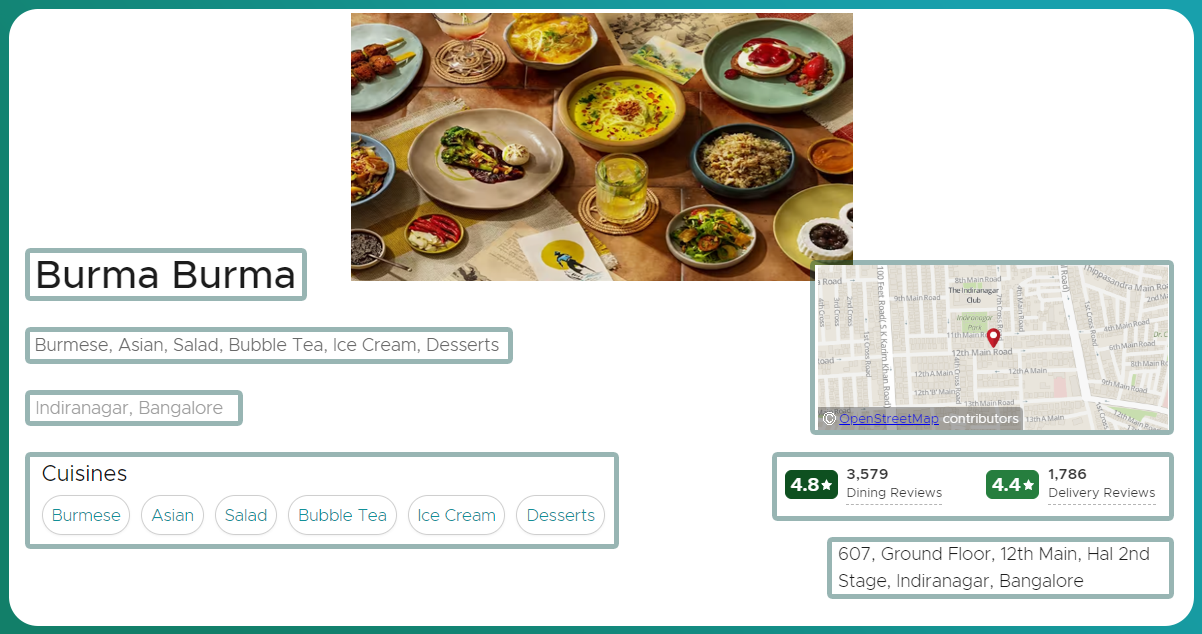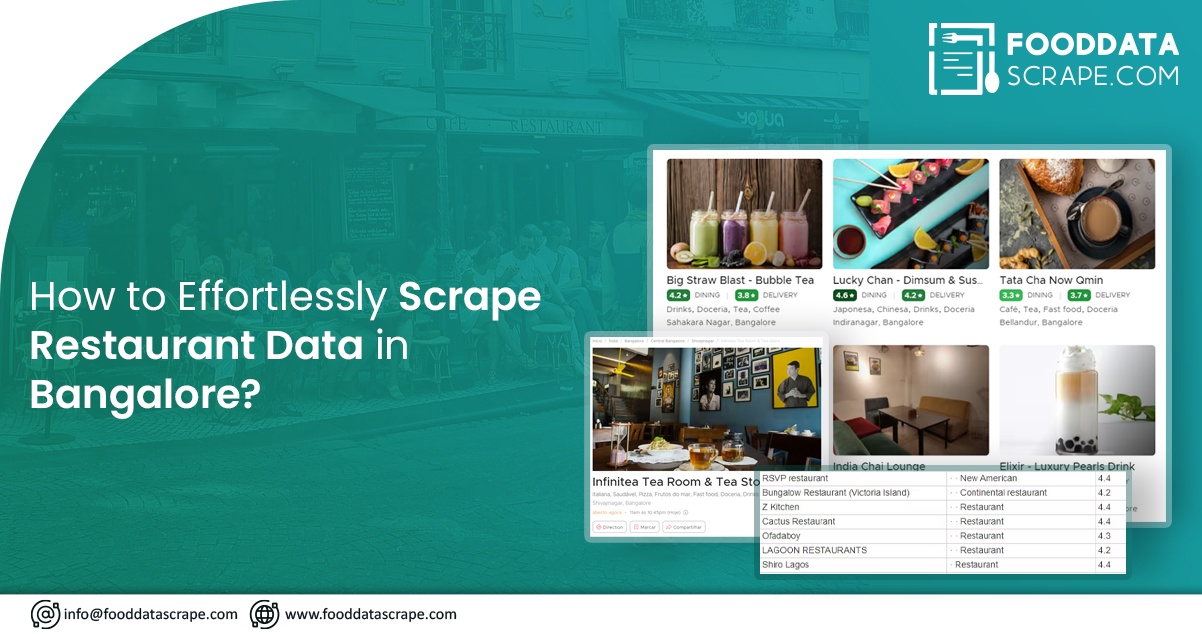Nestled in the heart of India, Bangalore, often affectionately referred to as the "Silicon Valley of India," possesses a unique identity that transcends its thriving tech industry. Beyond the world of startups and innovation, the city boasts a rich and dynamic culinary landscape that beckons food connoisseurs and gourmets from far and wide. This vibrant city has earned a well-deserved reputation as a melting pot of flavors, cultures, and gastronomic delights, making it a haven for those who savor diverse culinary experiences.
In this article, we embark on a journey through the multifaceted realm of scraping restaurant data in Bangalore, a city that takes its food as seriously as its technology. Here, we shed light on the profound significance and practical applications at the intersection of data and dining.
List of Data Fields

- Restaurant Name
- Food Menu
- Food Range
- Ratings
- Total Reviews
- Price Range
- Establishment Type
- Complete Address
- Restaurant Timing
- Contact Details
- Website, if available
- Photos
Significance of Scraping Restaurant Data in Bangalore
The allure of extracting restaurant data in Bangalore is undeniable, catering to diverse interests and needs. For starters, it serves as a digital compass for culinary exploration. With many restaurants offering a medley of cuisines, scraping food delivery data becomes a valuable tool for food enthusiasts seeking to navigate the city's diverse gastronomic landscape. It unveils hidden culinary gems, from street food stalls serving delectable local snacks to fine-dining establishments crafting exquisite global dishes.
However, the significance of restaurant data scraping services extends beyond pursuing gastronomic pleasures. For restaurant owners and managers, it opens doors to a treasure trove of business intelligence. This data offers insights into market trends, customer preferences, and operational performance. Armed with such information, these entrepreneurs can make well-informed decisions to refine their services, devise effective marketing strategies, and maintain a competitive edge in Bangalore's bustling restaurant industry.
Moreover, the world of data scraping in Bangalore empowers data analysts and researchers to delve into comprehensive studies on dining habits, pricing dynamics, and consumer behaviors. This data-driven approach provides a solid foundation for crafting insightful reports and contributing to a deeper understanding of the ever-evolving culinary landscape. Food delivery data scraping services open up a world of benefits and opportunities, catering to a diverse range of interests and needs:
1. Food Exploration:

For Food Enthusiasts: A restaurant data scraper is invaluable for food enthusiasts and gastronomes seeking culinary adventures. It offers a gateway to discovering new dining experiences, whether uncovering hidden gems serving authentic local cuisine or exploring upscale eateries offering global flavors. This data allows you to delve into diverse menus, culinary traditions, and the unique dining atmospheres of Bangalore's restaurants.
2. Business Insights:

For Restaurant Owners and Managers: The restaurant menu data scraping becomes a strategic asset for restaurant proprietors and managers. It equips them with essential insights into market trends, customer preferences, and the overall performance of their establishments. Analyzing customer reviews and ratings helps fine-tune offerings and service quality, facilitating data-driven decisions to enhance the dining experience and maintain a competitive edge in Bangalore's thriving restaurant industry.
3. Data Analytics:

For Data Analysts and Researchers: Restaurant data scraped from various sources serves as a goldmine for data analysts and researchers. It forms the foundation for in-depth studies into culinary preferences, pricing dynamics, and restaurant performance metrics. This wealth of information fuels data-driven insights, enabling the creation of comprehensive reports and contributing to a deeper understanding of Bangalore's ever-evolving culinary landscape.
4. Food Blogging and Reviews:

For Food Bloggers and Reviewers: Food bloggers and reviewers find a treasure trove of content in scraped restaurant data. Access to detailed restaurant information, including menus, customer feedback, and ratings, empowers them to craft informative and engaging content for their audience. This data-rich resource aids in curating restaurant reviews, culinary guides, and captivating narratives that resonate with fellow food enthusiasts and the wider community.
How to Scrape Restaurants in Bangalore?
Scraping Bangalore restaurant data entails a systematic process comprising several essential steps to ensure the successful extraction and utilization of valuable information:
1. Identify Data Sources: Determine the websites or online platforms from which you intend to extract restaurant data. These sources include popular restaurant review websites, comprehensive online directories, and food delivery platforms. Understanding the data landscape is critical for comprehensive scraping.

2. Select a Web Scraping Tool: Next, select an appropriate restaurant data scraping tool or library tailored to the requirements of your project. Python-based libraries like Beautiful Soup and Scrapy are popular among developers and data enthusiasts due to their versatility and effectiveness in web scraping tasks.

3. Define Data Fields: Define the precise data fields you aim to extract from the chosen sources. These fields typically encompass essential information such as restaurant names, physical addresses, contact details, comprehensive menus, customer reviews, and ratings. A well-defined set of data fields streamlines the scraping process.

4. Access the Websites: Develop a sophisticated scraping script or program meticulously designed to navigate the selected websites seamlessly. This script should simulate user interactions with the websites, including searching for restaurants based on various criteria such as location, cuisine, or user preferences. Effective user interaction emulation is fundamental for comprehensive data collection.

5. Data Storage: Once the scraping script collects the desired restaurant data, establish a structured data repository for efficient storage. Standard storage formats include relational databases, CSV (Comma-Separated Values) files, or JSON (JavaScript Object Notation) files. Properly organizing and storing the scraped data ensures accessibility for future analysis and retrieval.

6. Data Analysis and Visualization: Utilize various data analysis tools and techniques to extract meaningful insights from the scraped data. This analytical process unveils trends, patterns, and actionable information. To effectively communicate these findings, create visualizations, reports, or interactive dashboards that facilitate data-driven decision-making.

For comprehensive details, don't hesitate to contact Food Data Scrape. We're your one-stop solution for Food Data Aggregator and Mobile Restaurant App Scraping service. Our advanced insights and analytics empower informed decision-making, elevating your business strategies. Contact us today for data-driven success!
Get in touch
We will Catch You as early as we recevie the massage
Trusted by Experts in the Food, Grocery, and Liquor Industry






























































































